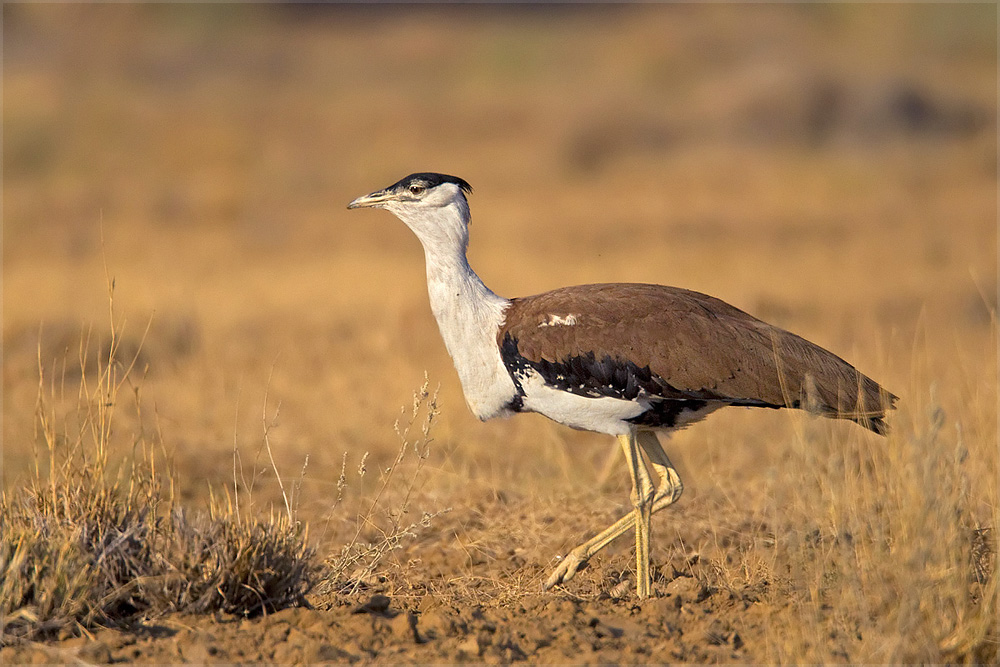The Wildlife Institute of India (WII) and the Rajasthan Forest Department have recently conducted a joint assessment of Great Indian Bustard status in Thar. The enclosed report describes the survey protocol and provides information on distribution, abundance and habitat of GIB and key associated wildlife in this crucial conservation landscape. We hope to replicate such surveys in other bustard landscapes with the kind cooperation of State Forest Departments so as to help managers in prioritizing and implementing site-specific actions.
The executive summary is enclosed below and the full report is available for download (click link on the right).
Executive summary
Despite unique biodiversity values and dependency of traditional agro-pastoral livelihoods, arid open habitats of India are facing imminent risk due to our neglect and mismanagement. The Critically Endangered Great Indian Bustard (GIB) acts as a flagship and indicator of this ecosystem, for which Governments are planning conservation actions that will also benefit associated wildlife. Persistence of this species critically depends on the Thar landscape, where ~75% of the global population resides, yet their status, distribution and ecological requirements remain poorly understood.
This study aimed at assessing the status of Great Indian Bustard, Chinkara and Fox alongside their habitat and anthropogenic stressors across ~25,500 sq km of potential bustard landscape in Thar spanning Jaisalmer and Jodhpur districts of Rajasthan. Systematic surveys were conducted in 144 sq km cells from slow-moving vehicle along 15-20 km transects to record species’ detections, habitat characteristics in sampling plots, and secondary information on species’ occurrence. Eighteen teams comprising of field biologists and Forest Department staff sampled 118 cells along 1924 km transect in March 2014. Species’ detection data were analyzed in Occupancy and Distance Sampling framework to estimate area of occupancy and density/abundance of key species.
Our key findings were that Great Indian Bustard occupied 5.8 ± 4.4 % of sites, although information from local community questionnaire surveys recorded usage in 27% of sites. Bird density was estimated at 0.61 ± 0.36 /100 sq km, yielding abundance estimates of 103 ± 62 in the sampled area (16,992 sq km) and 155 ± 94 GIB in Thar landscape (25,488 sq km area). During the survey, 38 individual birds were detected. Bustard-habitat relationships, assessed using multinomial logistic regression, showed that disturbances, level of protection and topography influenced distribution. Chinkara population occupied 91.0 ± 3.4% of sites at overall density of 378 ± 57 animals/100 sq km and abundance of 96,291 ± 14,556 in the landscape. Desert Fox population occupied 53.5 ± 8.8 % of sites, at overall density of 33.58 ± 8.17 animals/100 sq km and abundance of 8,558 ± 2,081 in the landscape. Seventy-five percent of priority conservation sites were outside Protected Area. Although some of them benefit from community protection, majority are threatened by hunting and unplanned landuses.
This study provides robust abundance estimates of key species in the Thar landscape. It also provides spatially-explicit information on species’ occurrence and ecological parameters so as to guide in-situ site-specific management and policy. Thar landscape supports the largest global population of GIB with the best hope for the species’ future survival. Since this survey was a snapshot at GIB distribution, landscape-scale seasonal use information is lacking but critically required. A satellite telemetry based study should be urgently implemented to prioritize areas for conservation investment.


 CI is a non-profit, non-commercial portal that aims to facilitate wildlife and nature conservation by providing reliable information and the tools needed to campaign effectively.
CI is a non-profit, non-commercial portal that aims to facilitate wildlife and nature conservation by providing reliable information and the tools needed to campaign effectively.